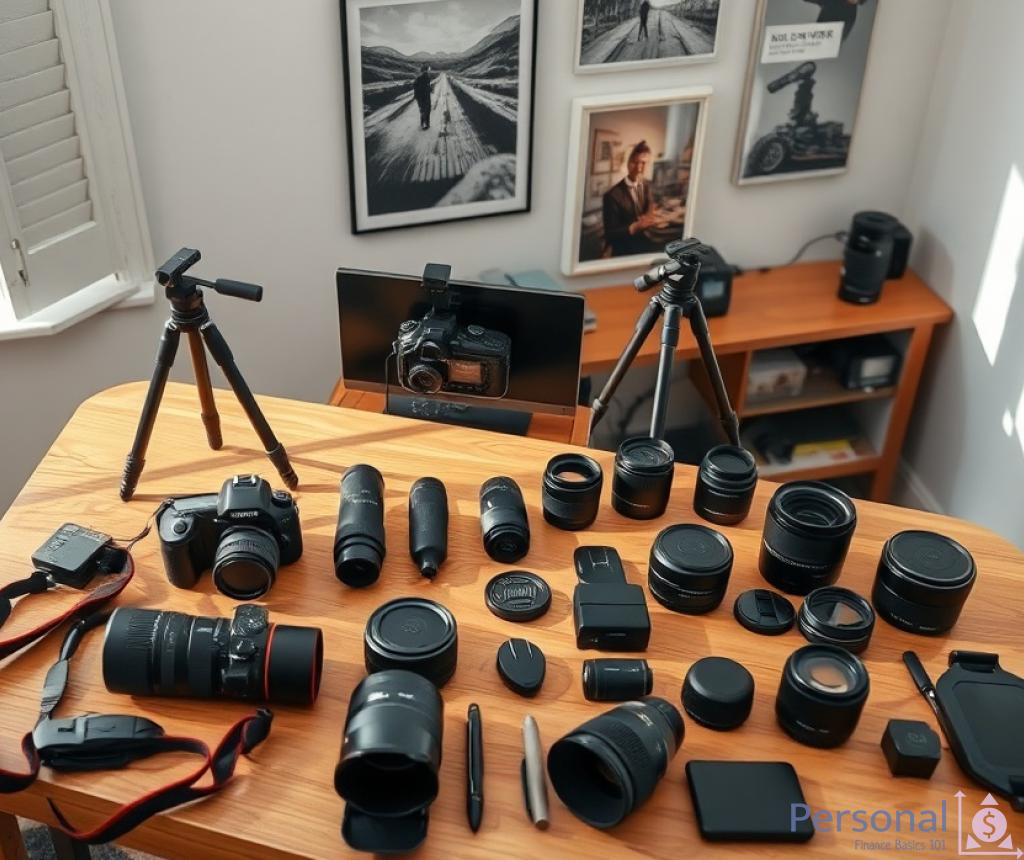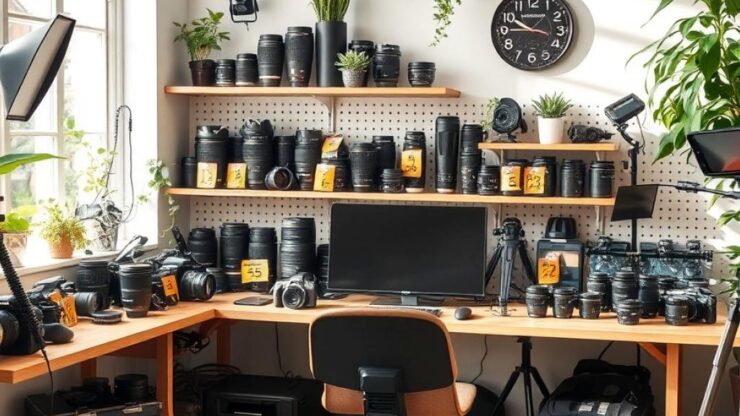Exploring Affordable Alternatives to High-End Gear

Understanding the Value of Entry-Level Gear
When embarking on your photography journey, understanding the value of entry-level gear can be a game changer. Many aspiring photographers feel compelled to invest in high-end equipment, thinking it will elevate their work. However, entry-level cameras and lenses often provide excellent quality and features that are more than sufficient for beginners and even intermediate users. By opting for affordable alternatives, you can focus on honing your skills without the burden of high costs.
Smart Choices: Budget-Friendly Brands
In the world of photography, several brands offer high-quality equipment at a fraction of the price of their high-end counterparts. These budget-friendly brands can deliver exceptional performance, making them ideal for photographers who want to save money while still achieving great results. Here are some notable brands worth considering:
- Canon – The Canon EOS Rebel series is a beloved choice among beginners.
- Nikon – The Nikon D3500 offers great features at an accessible price point.
- Sony – The Sony Alpha a6000 series is compact yet powerful.
- Fujifilm – The Fujifilm X-T200 is stylish and user-friendly.
- Panasonic – The Lumix G series provides excellent video capabilities as well.
Comparing Features: What to Look For
When searching for affordable alternatives to high-end gear, it’s essential to know what features matter most to your photography style. Here’s a comparison of key features to consider:
| Feature | High-End Gear | Affordable Alternative |
|---|---|---|
| Image Quality | Exceptional | Very Good |
| Low-Light Performance | Outstanding | Good |
| Durability | Professional Grade | Decent |
| Portability | Moderate | High |
| Price | High | Affordable |
As shown in the table above, while high-end gear typically excels in image quality and low-light performance, many affordable alternatives can meet the needs of most hobbyists and emerging professionals without breaking the bank. Assess your requirements and prioritize features that align with your photography goals.
Timing Your Purchases for Seasonal Discounts
For photographers looking to maximize their budget, understanding the timing of purchases can be a crucial strategy. Seasonal discounts provide a unique opportunity to acquire photography equipment at significantly reduced prices. By aligning your buying habits with these seasonal sales, you can enhance your gear collection while minimizing expenses. This approach not only allows you to invest in quality equipment but also gives you the chance to explore various brands and models without straining your financial resources.
Identifying Key Sales Periods is essential for taking advantage of discounts. Major retail events such as Black Friday, Cyber Monday, and end-of-season sales often feature photography gear at reduced prices. Additionally, manufacturers may offer promotions during product launches or around the holiday season, making it an opportune time for budget-conscious photographers to upgrade their equipment. Staying informed about these sale periods can empower you to make strategic purchases that align with your needs.
Leveraging Online Resources can also play a significant role in timing your purchases effectively. Subscribing to newsletters from photography retailers and following social media accounts can keep you updated on flash sales and exclusive offers. Many online platforms provide price tracking tools, which alert you when specific items drop in price, ensuring you never miss a deal. This proactive approach allows for informed decision-making, ultimately leading to better savings.
Moreover, consider the importance of patience in your purchasing strategy. While the lure of immediate gratification can be strong, waiting for the right moment to buy can yield substantial savings. By planning your equipment needs ahead of time and being willing to hold off on purchases until sales occur, you can take full advantage of seasonal discounts without compromising on quality. In the world of photography, timing isn’t just about capturing the perfect moment; it’s also about making savvy financial decisions that enhance your craft.
Utilizing Rental Services for Occasional Use
For photographers who may not require high-end equipment on a regular basis, utilizing rental services can be a smart financial strategy. Instead of investing in costly gear that will only be used sporadically, renting allows you to access top-tier equipment without the heavy financial burden. This approach not only saves money but also provides the flexibility to experiment with various tools that might enhance your photography experience.
Assessing Your Needs Before Renting
Understanding your photography needs is crucial before diving into rental options. Are you planning a one-time shoot that requires specialized lenses or cameras? Or do you need equipment for a series of projects? By clearly defining your requirements, you can make informed decisions about what to rent and for how long. This assessment helps avoid unnecessary costs associated with renting equipment that may not be utilized effectively.
Choosing the Right Rental Service
Not all rental services are created equal, and selecting the right one can significantly impact your experience. Here are key factors to consider when choosing a rental service:
- Reputation: Look for established rental companies with positive reviews from fellow photographers.
- Equipment Availability: Ensure the service offers a wide range of gear that fits your needs, from cameras to lenses and accessories.
- Pricing Structure: Compare rental rates, including any additional fees for insurance or late returns.
- Customer Support: A reliable rental company should provide excellent customer service, helping you with any questions or issues that arise.
Benefits of Renting Gear
Engaging in rental services offers numerous advantages that can enhance both your budgeting strategy and your photographic capabilities. Here are some distinct benefits:
| Benefit | Description |
|---|---|
| Cost-Effective | Renting eliminates the need for large upfront investments, allowing you to access high-quality gear without the financial strain. |
| Flexibility | Rental services enable you to try different equipment for various projects, ensuring you always have the right tools at your disposal. |
| Up-to-Date Technology | Many rental companies regularly update their inventory with the latest gear, allowing you to stay ahead in your photography endeavors. |
Ultimately, utilizing rental services can be a savvy approach for photographers seeking to save money while still gaining access to premium equipment. By carefully assessing your needs, choosing the right rental service, and understanding the benefits of renting, you can enhance your craft without overspending.
Buying Used Equipment: What to Look For
Embarking on your photography journey can be an exciting yet financially daunting experience. For many, the allure of brand new equipment is strong, but the reality is that purchasing used gear can be a savvy move that allows you to save significantly without sacrificing quality. When considering buying used equipment, it’s essential to approach the market with knowledge and discernment. This way, you can make informed choices that enhance your craft without straining your budget.
Evaluating Condition and Performance
When browsing the used equipment market, assessing the condition of the gear is paramount. Look for signs of wear and tear, such as scratches on the body or lens, and check for any functional issues like slow autofocus or sticky buttons. It’s advisable to ask the seller if the item has been serviced or repaired in the past. A well-maintained camera or lens can often perform just as well as a new one, provided it has been cared for properly. Additionally, if possible, test the equipment before purchasing. Bring your own memory card to take a few pictures and review them for image quality.
Understanding the Market Value
To avoid overpaying, familiarize yourself with the market value of the equipment you’re interested in. Research various platforms where used gear is sold, such as online marketplaces, local classifieds, and dedicated photography forums. Compare the prices of similar items to gauge a fair price range. Furthermore, consider the age of the equipment and any newer models that may have been released, as these factors can significantly influence pricing. Knowing what to expect will empower you to negotiate better and potentially save even more.
It’s also wise to inquire about the original purchase date and any warranty that may still apply. Some used gear may come with a limited warranty, providing an extra layer of security for your investment.
Building Relationships with Sellers
When purchasing used equipment, establishing a rapport with sellers can be beneficial. Whether you’re buying from a store or an individual, a trustworthy relationship can lead to better deals and insider tips on upcoming sales or available gear. Don’t hesitate to ask questions and express your specific needs; many sellers are passionate about photography and are willing to share their knowledge. Building a network within the photography community can also lead to exclusive offers and opportunities to acquire sought-after equipment at a lower price.
In summary, buying used photography equipment can be an excellent way to enhance your gear collection while keeping costs manageable. By carefully evaluating condition and performance, understanding market value, and building relationships with sellers, you can navigate the used equipment landscape with confidence. This approach not only stretches your budget but also allows you to explore various tools to elevate your photographic skills.
Maximizing Value Through Bundled Packages
In the quest for affordable photography equipment, savvy photographers often overlook the potential of bundled packages. These offerings combine multiple items into a single purchase, allowing you to acquire essential gear at a reduced overall cost. By recognizing the advantages of bundled packages, you can significantly enhance your photography toolkit without straining your budget.
Understanding the Benefits of Bundled Packages Bundled packages present a unique opportunity to maximize value. When you purchase items separately, the cumulative cost can quickly escalate. However, manufacturers and retailers frequently create bundles that include a camera body, lenses, tripods, and accessories at a lower price than buying each component individually. This approach not only saves money but also ensures you have all the necessary equipment to get started right away. Furthermore, bundles often include items that complement each other, such as filters or carrying cases, enhancing your overall photographic experience.
Identifying the Right Bundles for Your Needs To make the most of bundled packages, it’s crucial to assess your specific photography requirements. Are you interested in landscape, portrait, or wildlife photography? Understanding your primary focus will guide you in selecting bundles that contain relevant gear. For instance, a wildlife photography bundle may include a long telephoto lens, while a portrait package could feature a prime lens with a wide aperture. Additionally, consider the quality of the items included in the bundle. It’s essential to ensure that the gear meets your standards and is from reputable brands that offer durability and performance.
Timing Your Purchase for Optimal Deals Just as with individual equipment purchases, timing can play a pivotal role in securing the best deals on bundled packages. Keep an eye out for seasonal sales, promotional events, and manufacturer releases that may include discounted bundles. Signing up for newsletters from retailers can also keep you informed about exclusive offers. Taking these proactive steps can lead to substantial savings, allowing you to invest in high-quality gear that will elevate your photography skills.
Disclaimer
This article has been created or edited with the support of artificial intelligence and is for informational purposes only. The information provided should not be considered investment advice. Please seek the support of a professional advisor before making any investment decisions.






